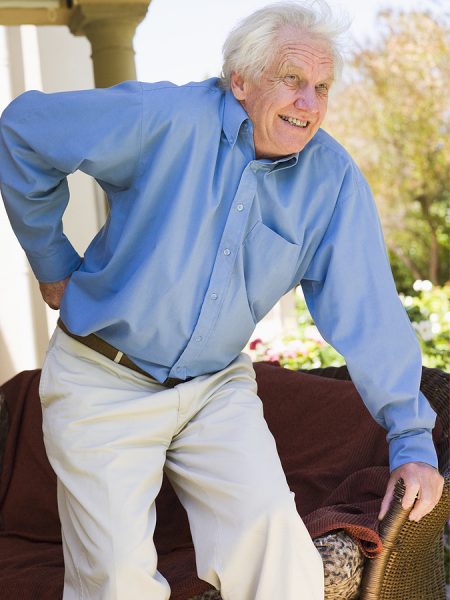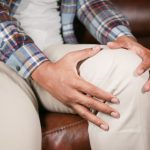By David Blyweiss, M.D., Advanced Natural Wellness
Back pain is the most common form of pain in the U.S. In 2019, 39.0% of people experienced some sort of back pain. And unfortunately, it hits almost everyone – around four out of every five people – at some point in their lives.
The good news is that most cases of back pain are temporary. About nine times out of ten pain improves without surgery. The bad news is that, during a flare-up, back pain can be excruciating and severely restrict daily activities. And there are a lot of reasons for it.
In most short-term cases back pain is likely caused by muscle strain. This can be caused by numerous reasons; lifting something heavy, repetitive movements, sleeping in the wrong position. You twist the wrong way, sit in the same position for too long or bend too far.
Bad posture is another reason for back pain. We slouch when we sit and hunch when we walk. Some people jut their hips forward, others push their derrieres out.
Excess weight is a problem. It places a huge burden on your back. All of that extra pressure causes muscles to tense up and pinch your nerves.
A lack of physical activity only adds to back problems. Movement keeps muscles strong, decreases bone loss and replenishes lubrication to joint cartilage. This helps reduce back stiffness and pain.
And let’s not forget about what excess stress does to your body. It tightens up your muscles and creates an inflammatory response that only contributes to back pain.
Age-related spinal degeneration such as disc degeneration, stenosis and arthritis are also quite common. A review of the Medicare database shows that the average frequency of diagnosed spinal degenerations is around 27.3% each year. Diagnoses seem to peak between the ages of 70 and 85.
On the bright side, most people whose MRIs and CT-scans show spinal degenerations don’t have any symptoms of pain at all. In fact, as many as 90% of people older than 60 who have disc degeneration live pain free!
So just because you’re back isn’t as young as it used to be, it doesn’t mean you’re destined for limited mobility with age.
Natural Treatments for an Aching Back
If your back is flaring up, it’s a good idea to pop a cold pack under the affected area for 20 minutes or so several times a day. When the pain starts to lessen, alternate with a heat pack to loosen up the muscles.
But don’t lie around “babying” it for more than a day or two. The longer you remain immobile, the worse your outcome will be.
Many of my patients find that chiropractic care and massage help get them over the worst of their symptoms more quickly.
I recommend looking for a full-service chiropractor who also offers massage and TENS treatments. These added offerings help loosen you up beforehand, which makes it much easier for the chiropractor to perform an alignment.
Even a regular massage is helpful. When your back muscles are stiff, tight and rigid, they place direct pressure on your vertebrae. This not only contributes to agonizing back pain, it can also delay recovery. A professional massage can help relieve those knotted muscles so that you heal more quickly. Plus, massage is a great stress reliever.
Soothing your aching muscles in a hot tub with jet sprays also works well. (If you don’t have access to one, you can get similar benefits by soaking in a warm bath containing Epsom salts along with some peppermint, spearmint or eucalyptus.)
For added relief, I recommend the application of a mentholated topical cream that contains 0.75% capsaicin to painful areas.
Taking a daily curcumin supplement can help, too. This powerful anti-inflammatory is widely recognized for its ability to relieve pain and inflammation. Look for one that is standardized to 90 to 95 percent total curcuminoids. And make sure it includes bioperine, a black pepper extract that substantially increases bioavailability.
Build a Stronger Back
I also suggest considering physical therapy – for both the short and the long run. A physical therapist can teach you specific exercises that strengthen your back and abdominal muscles and help improve posture.
A sample of these types of exercises include…
Leg stretches. Lay down flat on the floor with your legs straight. Bend your right leg at the knee and bring it in toward your chest. Use your hands to press the knee as far into your chest as possible. Hold for a count of ten and release. Repeat on left leg. Do these 3 or 4 more times.
Pelvic tilts. Lie on your back with your knees bent and your feet flat on the floor. Tighten your abdomen and curve it slightly upward with your back pressed to the floor. Hold for 10 seconds and release. Repeat 10 to 15 times.
Bridge Exercise. Lie on your back with your legs bent, feet flat on the bed or floor and your arms straight/flat at your sides. Exhale, tighten your abdomen and lift your rear-end upward. Hold for a few seconds, then release your abdomen and return to starting position. Repeat 10 times.
I also like tai chi and yoga. These gentle forms of exercise work just as well as physical therapy for reducing pain, improving function and straighten posture.
In the meantime, if you’ve tried everything at your disposal and have back pain continually for more than four to six weeks you really need to get it checked out, as it could be a symptom of a serious underlying health condition.
SOURCES:
Low Back Pain. © 2022 American Association of Neurological Surgeons.
Lucas JW, Conner EM, Jonaki B. Back, lower limb, and upper limb pain among U.S. adults, 2019. National Center for Health Statistics (U.S.). Division of Health Interview Statistics. 2021. NCHS data brief; no. 415.
Parenteau, C.S., Lau, E.C., Campbell, I.C. et al. Prevalence of spine degeneration diagnosis by type, age, gender, and obesity using Medicare data. 2021. Sci Rep 11, 5389.
Brinjikji W, Luetmer PH, Comstock B, Bresnahan BW, Chen LE, Deyo RA, Halabi S, Turner JA, Avins AL, James K, Wald JT, Kallmes DF, Jarvik JG. Systematic literature review of imaging features of spinal degeneration in asymptomatic populations. AJNR Am J Neuroradiol. 2015 Apr;36(4):811-6. Chou R, Deyo R, Friedly J, Skelly A, Hashimoto R, Weimer M, Fu R, Dana T, Kraegel P, Griffin J, Grusing S, Brodt ED. Nonpharmacologic Therapies for Low Back Pain: A Systematic Review for an American College of Physicians Clinical Practice Guideline. Ann Intern Med. 2017 Apr 4;166(7):493-505.






